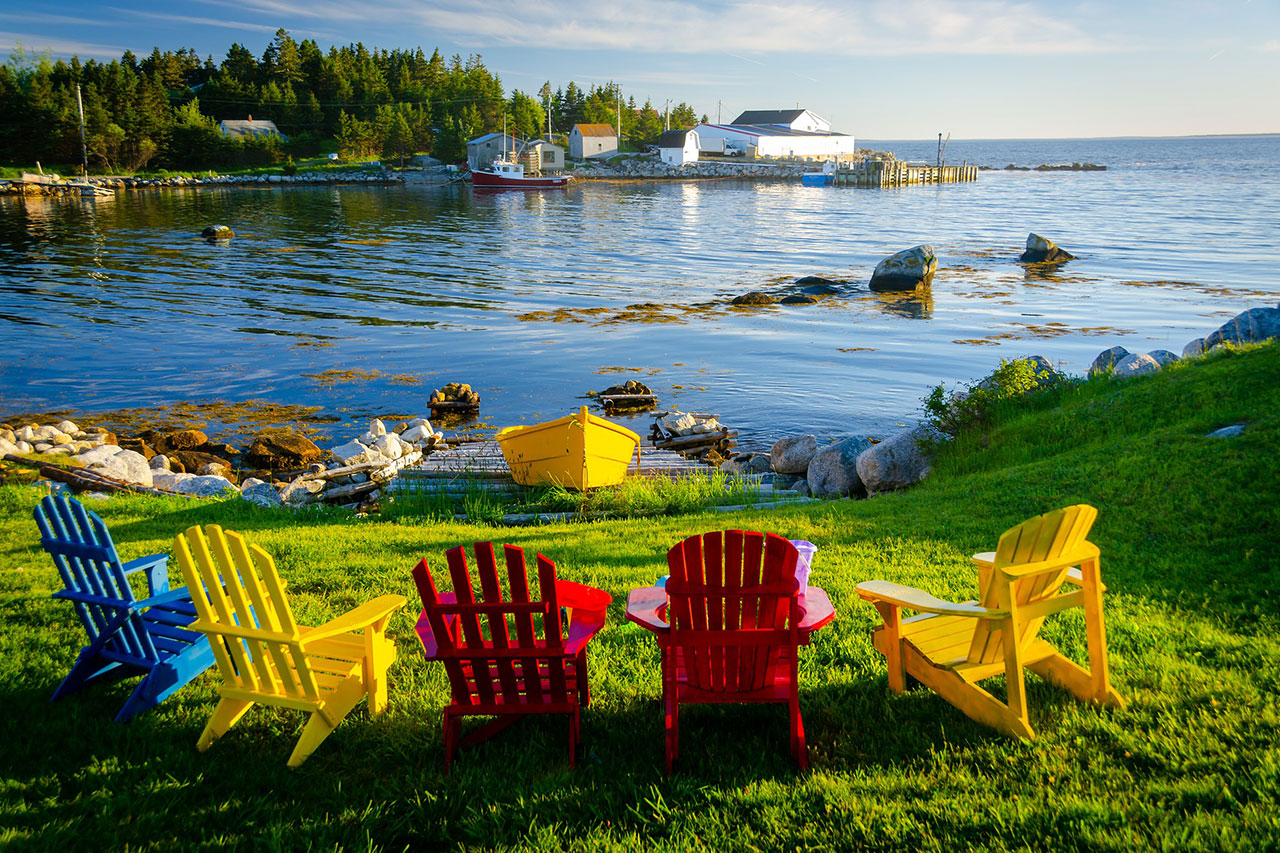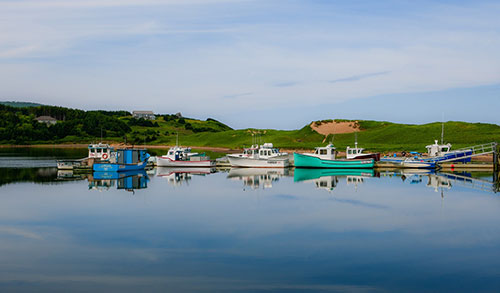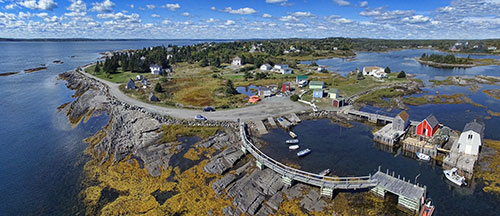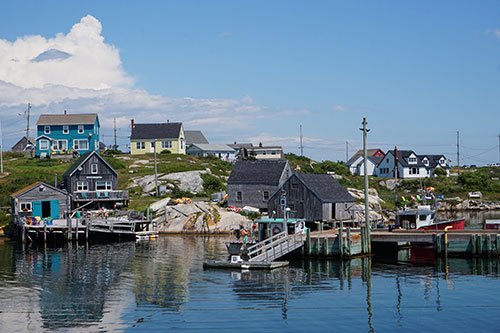Nova Scotia

The most populous province in the Maritimes, Nova Scotia is a peninsula surrounded by the Atlantic Ocean. The cradle of Acadia and Canada, it is in this province that the French colony of Port-Royal took root in 1604. Today, more than 32,000 Acadians still reside there. They are found mainly in the southwestern region (Clare and Argyle), Cape Breton (Chéticamp, Isle Madame) and Halifax, but also in Sydney, Truro, Pomquet, the South Shore region, Chezzetcook and in the Annapolis Valley, where the Grand-Pré National Historic Site is located.
96085
Knowledge of French
30250
French first official language
Source: Statistics Canada, 2016 Census
 Life in French
Life in French
Education

The Conseil scolaire acadien provincial (CSAP; Provincial Acadian School Board) has 19 French-language schools, including nine in the southwestern part of the province (Clare and Argyle regions), six in the Halifax area and three in Cape Breton.
Nova Scotia has several French-language early childhood centres and daycares, including Le Petit Voilier (Halifax), Papillons et Pissenlits (West Pubnico), Le jardin des petits (Tusket), La P’tite Académie (Church Point), Notre Jardin d’Enfance (Meteghan), Les Petits Poussins (Chéticamp) and La garderie des petites étoiles (Arichat).
Founded in 1890, Université Sainte-Anne offers college and university programs as well as immigrant training at its main campus in Church Point and its other campuses in Halifax, Petit-de-Grat, Saint-Joseph-du-Moine and Tusket.
Health

Réseau santé Nouvelle-Écosse maintains a directory of French-speaking health-care professionals.
The IWK Health Centre in Halifax provides French-language and interpretation services to Francophone patients whenever possible.
Centre de santé communautaire Sacré-Coeur (Chéticamp) provides services and care in French.
Digby General Hospital and the Clare Health Centre have health-care professionals who can provide health care services in French.
Economy

The Conseil de développement économique de la Nouvelle-Écosse is the main French-language organization in the field of economic development.
The Conseil coopératif acadien de la Nouvelle-Écosse also has an important role to play in economic development.
 Immigration
Immigration
Employment

The following are the main employment sectors:
- Fishing and seafood-processing
- Mining
- Tourism
- Shipbuilding
- Health care
- Information and communication technology
Settlement services

Located in Halifax, Francophone Immigration Nova Scotia offers free reception and integration services in French to newcomers.
The Conseil de développement économique de la Nouvelle-Écosse (CDÉNÉ) provides economic immigration services that facilitate the integration of Francophone immigrants into the labour market. The services are offered free of charge to Francophone immigrants and potential immigrants.
The Halifax campus of Université Saint-Anne offers a “Training and Work Experience” program, which helps Francophone immigrants to improve their level of English in order to find a job; to acquire the tools and techniques to conduct an effective job search; and to build a new network of contacts.
Welcoming Francophone Community

Clare
Located in southwestern Nova Scotia, approximately 300 km from Halifax, the Municipality of the District of Clare is situated on St. Mary’s Bay, home to more than 25 small villages between the towns of Digby and Yarmouth. Known for its joie de vivre, this Welcoming Francophone Community is proud to display its Acadian colours. While the cradle of Acadia, Grand-Pré, is nearby, Acadians started to settle in Clare in 1768, after the deportation. Today, the region is full of community and sporting activities, including the Festival acadien de Clare ¬ the oldest Acadian festival in existence ¬ and the Gran Fondo Baie Sainte-Marie, the largest cycling event in Atlantic Canada. The region will host the next Acadian World Congress, a major international cultural event, in 2024.
Some figures:
73.6% of the population knows French.
42.7% of people work in French.
Source: Statistics Canada, 2016 Census
 What to expect
What to expect
Climate
The west coast of Cape Breton is known for its strong southeasterly winds.
Summer
20°C
on average
Winter
-5°C
on average
Geography

PROVINCE
Composed of bays and estuaries, all parts of the province are within 50 km of the sea.
NORTHEAST
The Appalachian mountain region, with mixed forest.
POPULATION
Halifax is the most populous city with almost 300,000 inhabitants, followed by Sydney (just over 30,000) and Truro (23,000).
Access
The two main airports are Halifax Stanfield International and J.A. Douglas McCurdy Sydney.
There are also ferry services to Prince Edward Island and Newfoundland.
Nova Scotia is accessible by road from neighbouring New Brunswick; there is also a road to Cape Breton Island.
Read more
Francophonie highlights

• In 2004, on the 400th anniversary of the founding of Port-Royal, the Acadian community of Nova Scotia hosted the 3rd Acadian World Congress. The theme song, Je reviens au berceau de l’Acadie, was composed and performed by the group Grand Dérangement, originally from Baie Sainte-Marie.
• In 2016, after three years of legal proceedings, the Acadian community won a victory in court by overturning an electoral reform that eliminated three protected Acadian ridings (Clare, Argyle and Richmond).
History

One hundred French families founded Acadia in the 17th century by settling around Port-Royal, on the shores of the present-day Bay of Fundy. In 1755, four decades after the British conquest of Acadia, the British authorities deported the Acadians to the American colonies and to England. In 1764, they were allowed to return to Nova Scotia, provided that they did not form groups large enough to pose a threat. The Acadians dispersed and settled on the province’s coasts. The pre-deportation village of Pubnico was resettled by Acadians beginning in 1767, and settlements were established all along St. Mary’s Bay between 1768 and 1850. In Cape Breton, Acadians created communities in Chéticamp, Saint-Joseph-du-Moine and Isle Madame.
The economy of 19th century Acadia in Nova Scotia revolved mainly around fishing, seafood-processing, lumber and shipbuilding. In the 20th century, Acadians from Chéticamp created one of the most important cooperative movements in the province.





